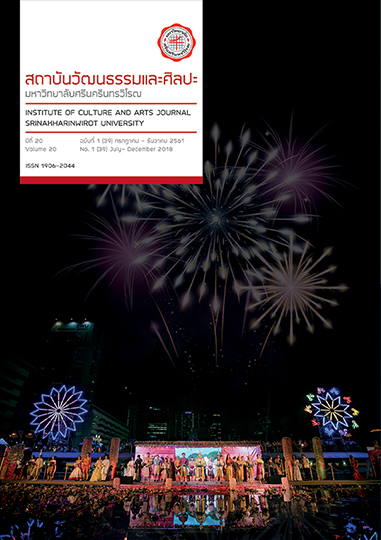A Study of Thai Ikat Silk’s Fabrication: Case Study at Pak Thong Chai District, Nakhon Ratchasima province.
คำสำคัญ:
Development of Thai ikat silk, Pak Thong Chai Thai ikat silk, Thai Fashion Industryบทคัดย่อ
This research aims to study history, development, production process and physical composition of Thai Ikat silk fabrics, which are fibers, colors, weaving techniques, patterns and finishing. Case study at Pak Thong Chai District, Nakhon Ratchasima province.
In qualitative research the tools for data collection are structured interviews with 2 groups of purposive sampling. The first group is two well-known and respected savants with knowledge of history in community and knowledge of Thai ikat silk for at least 10 years. The second group includes three manufacturers who are also distributors of Thai ikat silk in the area for at least 10 years. And Thai ikat silk products from these manufacturers must have community products standards (CPS) certified by the Thai Industrial Standards Institute (TISI), also must be selected for One Tambon One Product (OTOP) project and get at least 3 stars rating from OTOP Product Champion (OPC). Data were collected by in-depth interviews, group interviews and observation to investigate that if the communities are ready to develop Thai ikat silk to the Thai fashion industry in the future.
The results showed that Pak Thong Chai district, Nakhon Ratchasima Province is a source of Thai ikat silk that has inherited wisdom within the community until it has been known for a long time. Experienced in manufacturing handicrafts from ancestors to descendants to the present industrial systems. Using uncomplicated technology from folk wisdom in manufacturing helps maintaining costs. Also selecting quality fibers combined with varieties of colors and patterns, together with a fine hand-woven method, ready to use finishing, are reasons of product uniqueness. As a result, Pak Thong Chai district, Nakhon Ratchasima Province can be a proper supplier in materials for Thai fashion industry.
Downloads
เอกสารอ้างอิง
The Queen Sirikit Department of Sericulture, Ministry of Agriculture and Cooperatives. (2013). Washing and Dying. Retrieved March 27, 2017, from http://www.qsds.go.th/qsis_sout
กรมหม่อนไหม กระทรวงเกษตรและสหกรณ์. (2559). ภูมิปัญญาผ้าไหมไทย. สืบค้นเมื่อ 11 กรกฎาคม 2559, จาก http://qsds.go.th/newqsds/file_show/silkfinal2.pdf
The Queen Sirikit Department of Sericulture, Ministry of Agriculture and Cooperatives. (2016). Wisdom of Thai Silk. Retrieved July 11, 2016, from http://qsds.go.th/newqsds/file_show/silkfinal2.pdf
กันยารัตน์ วรฉัตร. (2557). ดร.ชาญชัย สิริเกษมเลิศ: มองทางรอดสิ่งทอไทย ด้วยเทคโนโลยีเพิ่มมูลค่า. สืบค้นเมื่อ 15 กุมภาพันธ์ 2560, จาก http://www.tcdc.or.th/creativethailand
Kanyarat Worachat. (2014). Dr. Chanchai Sirikasemlert: Value Added Technology, the survival of Thai textiles. Retrieved February 15, 2017, from http://www.tcdc.or.th/creativethailand
กิตติกรณ์ นพอุดมพันธุ์. (2559, มกราคม-มิถุนายน). การสร้างสรรค์เสื้อผ้าเครื่องแต่งกายจากทฤษฎีการรื้อสร้าง (Deconstruction): กรณีศึกษาผ้าไหมมัดหมี่พื้นบ้าน อำเภอปักธงชัย จังหวัดนครราชสีมา.
วารสารสถาบันวัฒนธรรมและศิลปะ. 17(2): 93.
Kittikorn Nopudomphan. (2016, January-June). Designing Fashion from Deconstruction Process: Case Study Ikat Silk in Pakthongchai, Nakhonratchasima Province.
Institute of Culture and Arts Journal. 17(2): 93
งามพิศ สัตย์สงวน. (2558). การวิจัยเชิงคุณภาพทางมนุษยวิทยา. พิมพ์ครั้งที่ 7. กรุงเทพ: สำนักพิมพ์แห่งจุฬาลงกรณ์มหาวิทยาลัย
Ngampit Satsanguan. (2015). Qualitative Research in Anthropology. 7th edition. Bangkok: Chulalongkorn University Press.
ฐิติศักดิ์ เวชกามา. (2559). แนวคิด ทฤษฎี วัฒนธรรม. พิมพ์ครั้งที่ 3: มหาสารคาม: คณะวัฒนธรรมศาสตร์ มหาวิทยาลัยมหาสารคาม.
Thitisak Wechkama. (2016). Concept Theory Culture. 3rd edition. Mahasarakham: Faculty of Cultural Science, Mahasarakham University.
นวลแข ปาลิวนิช. (2542). ความรู้เรื่องผ้าและเส้นใย (ฉบับปรับปรุงใหม่). กรุงเทพฯ: ซีเอ็ดยูเคชั่น.
Nualkhair Paliwanit. (1999). Knowledge of fabrics and fibers (Revised edition). Bangkok: SE-EDUCATION Public Company Limited.
ประชาชาติธุรกิจออนไลน์. (2557). ดีไซเนอร์แบรนด์ดังแชร์ไอเดียนำผ้าไทยลงจาก "หิ้ง". สืบค้นเมื่อ 15 กุมภาพันธ์ 2560, จาก http://www.prachachat.net
prachachat.netonline. (2014). Famous Designer Shares the idea of Bringing Thai fabric down from the "shelf". Retrieved February 15, 2017, from http://www.prachachat.net
พนิดา สวนเสรีวานิช. (2559). หลังม่านไหม ‘จิม ทอมป์สัน’ สุรินทร์ ศุภสวัสดิ์พันธุ์ ‘คุณภาพ’ คือหัวใจความสำเร็จ. สืบค้นเมื่อ 15 กุมภาพันธ์ 2560, จาก http://www.matichon.co.th
Panida Suansayreewanit. (2016). Behind Jim Thompson’s silk curtain Surin Suppasawatpan “Quality” is the heart of success. Retrieved February 15, 2017, from http://www.matichon.co.th
ศูนย์ส่งเสริมศิลปาชีพระหว่างประเทศ (องค์การมหาชน). (ม.ป.ป.). หอสุพรรณ-พัสตร์. สืบค้นเมื่อ 15 สิงหาคม 2561, จาก http://www.sacict.or.th
The SUPPORT Arts and Crafts International Centre of Thailand (Public Organization). (n.d.). Gold and Textiles Gallery. Retrieved August 15, 2018, from http://www.sacict.or.th
สถาบันพัฒนาอุตสาหกรรมสิ่งทอ. (2555). ผลการศึกษาวิจัยและพัฒนาต้นแบบไหมไทยร่วมสมัย. สืบค้นเมื่อ 25 กรกฎาคม 2559, จาก http://www.okmd.or.th
Thailand Textile Institute. (2012). The Results of Research and development of contemporary Thai silk. Retrieved July 25, 2016, from http://www.okmd.or.th
สถาบันพัฒนาอุตสาหกรรมสิ่งทอ. (2556). รายงานโครงการศึกษาวิจัยอัตลักษณ์ไหมไทยและโอกาสทางการตลาดของผลิตภัณฑ์ไหมไทยร่วมสมัย. กรุงเทพฯ: สถาบันพัฒนาอุตสาหกรรมสิ่งทอ กระทรวงอุตสาหกรรม
Thailand Textile Institute. (2013). Research Report on Thai Silk Identity and Marketing Opportunities of Contemporary Thai Silk Products. Bangkok: Thailand Textile Institute, Ministry of Industry.
สาตราวุฒิ คำสุข. ปราชญ์ชาวบ้าน. สัมภาษณ์วันที่ 7 เมษายน 2560.
Sadtrawut Kumsuk. Local savant. Interviewed on April 7, 2017.
สำนักพัฒนาการประชาสัมพันธ์ กรมประชาสัมพันธ์. (2553). ผ้าไหมโคราช. สืบค้นเมื่อ 15 กุมภาพันธ์ 2560, จาก http://hq.prd.go.th/prtechnicaldm
PR Technical Development Office, Public Relations Department. (2010). Korat Silk. Retrieved February 15, 2017, from http://hq.prd.go.th/prtechnicaldm
สำนักพัฒนาและถ่ายทอดเทคโนโลยีหม่อนไหม กรมหม่อนไหม. (2559). สรุปปริมาณ มูลค่า นำเข้า-ส่งออก รังไหม เส้นไหม ผ้าไหม และผลิตภัณฑ์ไหม ปี 2556-2558. สืบค้นเมื่อ 15 กุมภาพันธ์ 2560, จาก http://qsds.go.th/odt_new
Develop and Disseminate Technology of Sericulture Institute, The Queen Sirikit Department of Sericulture. (2016). Import-export Value Quantitative summary of Silk Cocoon, Silks, Silk Textiles, Silk products for 2013-2015. Retrieved February 15, 2017, from http://qsds.go.th/odt_new
อ้อยทิพย์ เกตุเอม. (2558). ของดีโคราช เล่ม 6: ผ้าโคราช. นครราชสีมา: สำนักศิลปะและวัฒนธรรม มหาวิทยาลัยราชภัฏนครราชสีมา
Aoythip Gaytaym. (2015). Korat Goods Book 6: Korat Textiles. Nakhon Ratchasima: Art and Culture Institute, Nakhon Ratchasima Rajabhat University
อาทิตยา สิริมัชชาดากุล. เจ้าของกิจการ. ร้านมัชชาดาไหมไทย. สัมภาษณ์วันที่ 9 กรกฎาคม 2559.
Atitaya Sirimatchadakul. Owner. Matchada Thai Silk. Interviewed on July 9, 2016.
mamminnie. (2017). Travel, Full of merit, Pottery and Silk Sightseeing at Korat. Retrieved October 5, 2017, from http://www.maamjourney.com/2017
mamminnie. (2560). ท่องเที่ยว อิ่มบุญ ดูเครื่องปั้น ชมผ้าไหมที่โคราชบ้านเฮา. สืบค้นเมื่อ 5 ตุลาคม 2560, จาก http://www.maamjourney.com/2017
Charlotte Mankey Calasibetta. (1998). Fairchild’s Dictionary of Fashion (Second Edition). United States of America: Fairchild Publications, adivision of ABC Media, Inc.
Olivier Gerval. (2008). Fashion Concept to Catwalk. United Kingdom: A&C Black Publishers.
ดาวน์โหลด
เผยแพร่แล้ว
รูปแบบการอ้างอิง
ฉบับ
ประเภทบทความ
สัญญาอนุญาต
บทความทุกบทความที่ได้รับการตีพิมพ์ถือเป็นลิขสิทธิ์ของวารสารสถาบันวัฒนธรรมและศิลปะ มหาวิทยาลัยศรีนครินทรวิโรฒ



